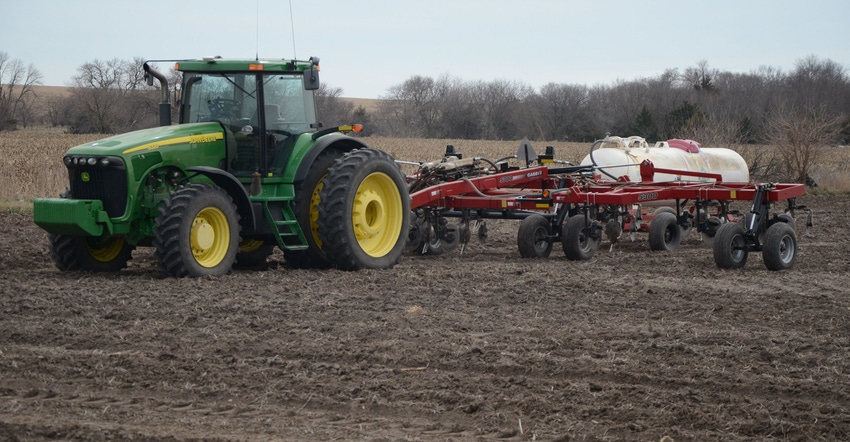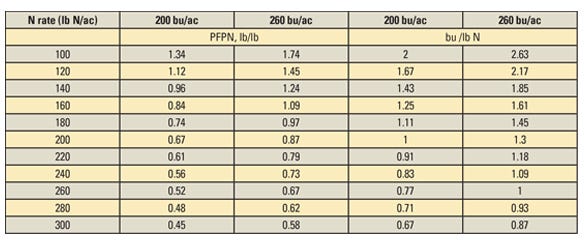April 16, 2019

Nitrogen use efficiency and minimizing nitrogen losses to the environment are ongoing economic and environmental concerns for crop production. Are there opportunities for improvement in N management for corn production?
Partial factor productivity
Partial factor productivity is a measure of input use efficiency. PFP is commonly expressed as yield per unit input — for example, bushels of corn per pound of N applied (bushels per pound N). PFP can be adapted to units of nutrient removed in grain harvest to units of nutrient applied, such as corn N harvested relative to fertilizer N applied (PFPN, pound per pound).

Table 1. Partial factor productivity for fertilizer N based on N removal in harvest (PFPN, pounds grain N per pound fertilizer N, pound per pound) and bushels of corn harvest per pound of fertilizer N applied (bushels per pound N) with 200 and 260 bushels per acre corn grain harvest.

Table 1 shows highest PFPN with low N rates, but in reality, the N rates generally need to be high enough for maximum profitability.
The PFPN used for this analysis was derived from growers’ practices statewide with the assumption that growers’ N use was aimed at profit maximization.
The average PFP of fertilizer N for corn in Nebraska was estimated to average 1.16 bushels per pound N in 2012, compared with 0.57 bushels per pound N in 1965. This represents a doubling in PFP for fertilizer N applied to corn.
Assuming a grain N concentration of 1.2% at 84.5% dry weight, or 0.67 pounds N per bushel, the PFPN converts to 0.79 pounds of grain N per pound of fertilizer N applied in 2012 compared with 0.38 pound per pound in 1965.
Other sources of N — including applied manure, ammonium deposition, irrigation water and mineralized soil organic N — need to be credited when determining fertilizer N rate at the field level. However, these N sources are recycled statewide over time and not considered in calculation of PFPN with exceptions.
In Nebraska, about 60% of corn follows soybean in rotation, and 40% follows corn or another crop. A higher PFP is expected with corn following soybean compared with other crops because of less fertilizer N being applied — and often higher corn yields.
Allocation of the overall PFPN of 0.793 pound per pound requires some assumptions. If average PFPN is 0.700 for corn following corn or another crop, then PFPN for corn following soybean is about 0.855 with only the corn component considered.
Soybeans, on average, get about 45% of their N from the soil and 55% from biological N fixation. Nitrogen removed in soybean grain harvest exceeds the N from biological N fixation.
Soybean yields of 50 and 65 bushels per acre remove about 85 and 110 pounds of soil N per acre, respectively, assuming 3.8 pounds of N per bushel. This results in PFPN of greater than 1.0 pound per pound for the corn-soybean rotation. Overall, PFPN is high for the corn-soybean rotation.
Nitrogen losses
Leaching and volatilization each can account for about 30% of total N loss in Nebraska, while erosion and runoff account for about 22%, denitrification accounts for 12%, and N2O and NO emissions account for 6% — although much variation exists in each of these estimates from field to field.
For example, more volatilization is expected with broadcast applications on high residue fields with high pH soil, while most denitrification is expected on poorly drained bottomlands, and most erosion and runoff loss are expected from highly erodible lands.
Decision tools such as Maize N and the Nitrogen Loss Assessment Tool (NebGuide G2249) can be used to assess risks of N loss.
There is, however, much field-to-field difference in N loss, especially because of leaching and denitrification "hot spots" for loss. More than 50% of the N loss to leaching likely may occur from only 20% of the corn land.
The "hot spots" for leaching loss are partly indicated by high nitrate-N in groundwater and associated with sand content of soil, as well as past and current N and irrigation practices.
Nitrogen leaching hot spots are expected to occur more frequently:
• in continuous corn rotations
• in sandy soils
• in furrow irrigation rather than pivot irrigation or rainfed
• with preplant time applications of all fertilizer N compared with 50% or more applied in-season
Practices to reduce N loss with corn production in Nebraska need to be well-targeted to the specific N loss situation. Application rates and times should get the most consideration. A significant reduction in N rate can result in little or no profit loss and can be a cost-effective means to reduce N loss.
Application of most of the fertilizer N in-season, especially if in response to crop N need, can be highly effective for situations with high potential for leaching and denitrification loss.
Slow release fertilizer N products and N loss inhibitors can be cost-effective if targeted to high loss situations and used at the right time. Good irrigation management is important to reduce leaching loss. Planting cover crops can help reduce N loss if there is enough growth, and if cover crops are terminated early enough to avoid the need for additional N.
Adequately crediting manure N, such as by applying only 60 pounds per acre fertilizer N preplant with the remaining applied in-season according to crop need is a great opportunity to reduce N loss for manured fields.
This report comes from UNL CropWatch, which is solely responsible for the information provided and is wholly owned by the source. Informa Business Media and all its subsidiaries are not responsible for any of the content contained in this information asset.
You May Also Like




